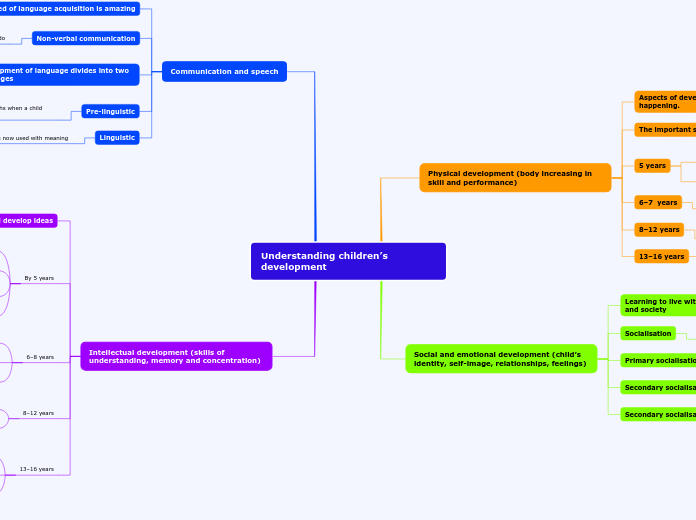Understanding children’s development
Physical development (body increasing in skill and performance)
Aspects of development that we can see happening.
Grown in terms of size, height and weight
The important skills of using our bodies
Use of large muscles to walk, run, climb, jump and skip and the use of our smaller muscles
5 years
Easily dresses and undresses
Draws a person with a head, body and legs, and a house
Runs quickly
Forms letters and writes own name
6–7 years
Enjoys hopping, bike riding, roller blading and skating
Controls pencil in a small area and does detailed drawing
8–12 years
Puberty starts around 10 for girls with a growth spurt and increase in body strength
Improves physical skills that have already developed
13–16 years
For girls puberty is complete at about 14 and periods start. For boys puberty is 13–16 and they will be stronger than girls
Social and emotional development (child’s identity, self-image, relationships, feelings)
Learning to live with others in both our family and society
Family and friends play an important part
Socialisation
Learning to cope in the family and society we live in
Primary socialisation
Takes place within the family, in the first years of a child’s life
Secondary socialisation
Regular contact with people and settings outside their home.
Playgroup, nursery and school, and continues throughout life.
Secondary socialisation teaches children
How to interact with adults who are not family
How to interact with friends and others
The‘rules’ of society, what is acceptable and what is not outside the home
Communication and speech
The speed of language acquisition is amazing
By eight months a child will be babbling sounds like ‘dadada’, by 18 months he or she will be using 30–40 words and by three years a child will be constructing complex sentences
Non-verbal communication
Children probably use it more than adults do
The development of language divides into two distinct stages
Pre-linguistic
Linguistic
Pre-linguistic
The stage up to about 12 months when a child starts to say his first words.
Linguistic
Words now used with meaning
Intellectual development (skills of understanding, memory and concentration)
How children learn, think and develop ideas
By 5 years
Copies square, and range of letters
Colours pictures neatly
Knows time of day for basic activities, for example breakfast, bedtime
Counts to 20 by rote
6–8 years
Able to understand concept of conservation
Great curiosity in relation to workings of his or her environmen
Understands the use of symbols in maths, writing, etc.
8–12 years
Can reason and apply logic to problems
Reading and writing confidently
13–16 years
Developing ability to think abstractly
Will question sources of information
Becoming more globally aware
